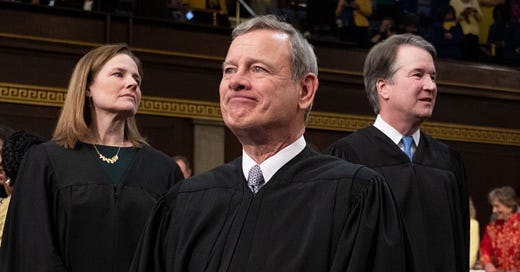Bonus 107: The Supreme Court in the Second Trump Administration
Standing up to President Trump in 2025 and 2026 is going to be a lot harder for the Court than it was in 2019 and 2020—and, the way things are going, a heck of a lot more important.
Welcome back to the weekly bonus content for “One First.” Although Monday’s regular newsletter will remain free for as long as I’m able to do this, much of the bonus content is behind a paywall as an added incentive for those who are willing and able to support the work that goes into putting this newsletter together every week. I’m grateful to those of you who are already paid subscribers, and hope that those of you who aren’t will consider a paid subscription if and when your circumstances permit:
Obviously, the only thing to write about today is what Tuesday’s election results mean for the Court. In future issues, I’ll cover some of the more concrete topics—like the odds that we’ll see any voluntary retirements by next summer (for various reasons, I think it’s somewhat unlikely); and what the change in administration will mean for cases currently pending before the Court (and some big ones that are on their way, at least for now). But for today, I wanted to pitch the question in much broader terms—with Republicans seemingly on the verge of unified control of the federal government come January 20, 2025, and, given the likely Senate margin, with no reason to believe that President-Elect Trump will be beholden to any moderating influences from either chamber of Congress. In that universe, it seems more than likely that the Supreme Court—this Supreme Court—will be the only institution standing between Trump and … whatever Trump wants to do.
That not-especially-incisive point may give some readers palpitations and others solace. But it underscores a point that I have been trying to make since before launching this newsletter—that we need a Supreme Court with broad-spectrum public credibility, entirely so that, if and when it’s the last institution standing up for the rule of law, it is still able to expect that its judgments will be enforced.
That harsh reality puts a significant burden on the justices whose votes will be most decisive in those cases—Chief Justice Roberts, Justice Kavanaugh, and Justice Barrett. And it drives home why the Court and the justices as individuals should have been more invested, over these past four years, in shoring up its support rather than repeatedly acting in ways that, among large parts of the public, undermined it. As a result, standing up to Trump in 2025 and 2026 is going to be a lot harder than it was in 2019 and 2020—and, the way things are going, a heck of a lot more important.
For those who are not paid subscribers, the next free installment of the newsletter will drop on Monday morning. For those who are, please read on.
Keep reading with a 7-day free trial
Subscribe to One First to keep reading this post and get 7 days of free access to the full post archives.




